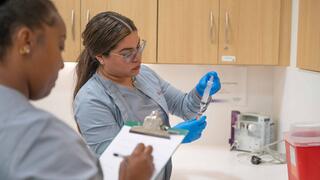Patient First: Math and Nursing Faculty Collaboration Prioritizes Patient Safety and Provider Confidence
Faculty update Clinical Mathematics course to improve nursing students' calculation skills.

Medication errors, which result in 1-2 million hospitalizations and 100,000 to 200,000 deaths on average per year, are a significant safety concern for patients and medical providers alike. About 41% of medication errors are because of incorrect dosage calculation, with calculations required for all types of medications – from IVs, to oral liquid medications, to pills. Thus, it is vital that nursing students be properly equipped with the necessary math skills to calculate dosages before they begin treating patients.
Not to worry – a collaboration between math and nursing faculty at Saint Joseph’s University is working to combat this problem before it even arises. To improve nursing students’ proficiency with dosage calculations, faculty have collaborated across departments to revamp Clinical Mathematics, a preliminary math course for students in the School of Nursing and Allied Health.
Course modifications were based on recommendations from a 2017 national math education in nursing initiative out of the University of Texas’s Charles A. Dana center. The national taskforce was co-led by Daniel Ozimek, PhD, associate professor of practice of mathematics and a key member of the Saint Joseph’s collaboration.
Ozimek co-published a study detailing the necessity of effective mathematics pedagogy in nursing with Kristen Zulkosky PhD, RN, CNE, CHSE, former clinical professor of graduate nursing, Brandi Morgante Handzlik EdD, assistant professor of practice of mathematics, and Lindsay Good MEd, instructor of practice of mathematics. The study explores nurse educators’ self-efficacy in teaching mathematics and their access to the appropriate instructional resources. It concludes that nursing instructors “need meaningful professional development regarding mathematics pedagogy,” with institutions recommended to adjust curricula to best support nursing students’ math skills.
Ozimek says course developments have made the student learning experience more hands-on, mirroring real-world patient scenarios. This helps arm students with the knowledge they need in clinical practice, from labor and delivery to the ICU.
“We've worked with our nursing colleagues to make sure that the problems we utilize in the dosage situations are authentic to practice,” Ozimek says.
Beth Russell, MSN, RN, IBCLC, clinical instructor of undergraduate nursing and another member of the collaboration, says all course developments center around the importance of maximizing patient safety.
“We need our students to understand the importance of math in clinical practice,” Russell says. “It’s not just being able to do the math on paper, it’s being able to apply it to a clinical setting where we have to calculate an ordered dose. It is not uncommon that the provider-ordered dose does not match the medication obtained from the pharmacy. Therefore, nurses need to be able to appropriately calculate how much of the medication to administer to ensure the patient receives the correct dose.”
The collaborative aspect of the course developments is key to preparing students as much as possible, especially in scenarios where giving a patient the incorrect dosage could be fatal.
“The collaboration at our institution has been so important because our nursing faculty are the ones that have experienced those situations,” Ozimek says. “They have stories where they have caught an error in practice, that maybe a colleague had prepared a dose and was prepared to give. And they tell their students.”
The hands-on approach of the course manifests in different ways. When the course is run online, students can use virtual syringes and tools through a resource developed by Ozimek and his colleagues called www.dosagemath.com. Users can choose from a variety of exercises like an oral dosage cup simulator, which allows students to fill the cup a certain amount. Students can then enter the strength of the medication and type in the amount that should be administered.
When the course is taught in-person, IV bags, tubing and syringes without the needle are incorporated in lessons. Course components like this, Ozimek says, teach students to “pick out the right tool” for different treatment situations.
Sharp calculation skills, Russell says, are vital despite the existence of calculation technology, as these systems are imperfect and can shut down. If a student is in an emergency situation where technology fails, their computation skills can minimize potential risks.
“We're really just keeping that patient safety lens in the forefront,” Russell says.
Teaching clinical nursing courses typically taken later in a student’s academic career, Russell says the improvements made to Clinical Mathematics serve as great groundwork both for future exams and real-life scenarios with patients.
Feedback from nursing faculty, Ozimek says, has been positive, with instructors excited to utilize the collaboration’s developments. The positive feedback the collaboration received reflects broader movements to support refined teaching methods that best suit students’ needs.
“We've heard from more and more individuals who are becoming aware of the work that we're doing, and more generally, the bigger picture, and are opening their arms to activities and improving instructional techniques and things in their classes,” Ozimek says.



